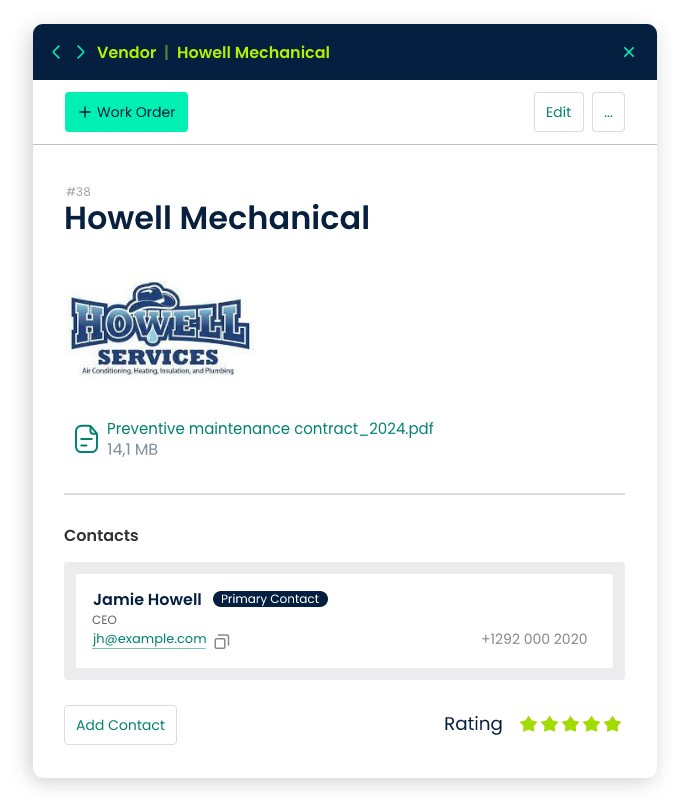
Maintenance Contracts: Supporting Smooth Operations and Predictable Costs
For businesses, maintenance contracts are invaluable tools for ensuring uninterrupted operations and protecting valuable investments. Maintenance contracts help operations by establishing maintenance schedules, which can mitigate the risk of unexpected breakdowns, reduce costly repairs, and extend the lifespan of critical assets. Moreover, contracts offer a predictable cost structure, allowing businesses to plan budgets and avoid unexpected expenses associated with unplanned maintenance events.
Similarly, individuals can benefit significantly from maintenance contracts, particularly for high-value assets such as HVAC systems, automobiles, or home appliances. These contracts provide peace of mind by ensuring that essential equipment receives regular upkeep and timely repairs, thus avoiding inconvenient breakdowns and costly emergency services. Additionally, maintenance contracts can contribute to energy efficiency, safety, and overall comfort within residential settings.
Maintenance contracts encompass a variety of services tailored to meet the specific needs of the client's assets. These services typically include regular inspections, preventive maintenance, troubleshooting, repairs, parts replacements, and emergency support when needed. The scope of these contracts can vary depending on the types of assets involved, ranging from simple preventive maintenance for household appliances to comprehensive contracts for industrial machinery and commercial facilities.
What are Maintenance Contracts?
Maintenance contracts are formal agreements between service providers and clients that outline a set of services and responsibilities related to the upkeep, repair, and support of assets, equipment, or systems. These contracts establish a predetermined schedule for maintenance activities, which can include routine inspections, preventive maintenance tasks, troubleshooting, repairs, parts replacements, and emergency support services.
The scope of maintenance contracts can vary widely depending on the nature of the assets involved and the specific needs of the client. For instance, maintenance contracts may cover anything from household appliances and HVAC systems to industrial machinery, commercial facilities, or even entire infrastructure networks.
Maintenance contracts serve several key purposes:
- Proactive Maintenance: By establishing a regular schedule of maintenance tasks, maintenance contracts enable proactive upkeep of assets, helping to prevent potential issues before they escalate into costly breakdowns.
- Predictable Costs: Maintenance contracts typically offer a fixed or predictable cost structure, allowing clients to budget effectively and avoid unexpected expenses associated with unplanned maintenance events.
- Asset Longevity: Regular maintenance prescribed in maintenance contracts can extend the lifespan of assets, ensuring optimal performance and maximizing their value over time.
- Minimized Downtime: Maintenance contracts often include provisions for priority service and emergency support, minimizing downtime and disruptions to operations in the event of equipment failures or malfunctions.
Types of Maintenance Contracts
1. Comprehensive Maintenance Contracts
Comprehensive maintenance contracts offer an extensive and all-encompassing approach to maintenance, covering a broad spectrum of services aimed at ensuring the optimal performance and longevity of assets. These contracts provide in-depth coverage of all aspects of maintenance, from routine inspections to emergency repairs, with the goal of addressing any potential issues before they escalate into major problems.
In-depth Coverage of All Aspects of Maintenance
Comprehensive maintenance contracts leave no stone unturned when it comes to the upkeep of assets. They involve thorough assessments, regular inspections, meticulous servicing, and prompt resolutions of any identified issues. Unlike other types of contracts, comprehensive agreements provide a holistic approach to maintenance, taking into account every component, system, and function of the asset.
Examples of Services Included in Comprehensive Contracts
The services included in comprehensive maintenance contracts can vary depending on the nature of the assets and the specific needs of the client. Examples of services commonly found in these contracts include:
- Regular inspections: Scheduled assessments to identify any signs of wear, damage, or malfunction.
- Preventive maintenance: Proactive measures to address potential issues before they lead to equipment failure.
- Corrective maintenance: Prompt repairs or replacements of faulty components, parts, or systems.
- Emergency support: Rapid response and resolution of unexpected breakdowns or malfunctions.
- Parts and labor: Coverage for the cost of replacement parts and associated labor fees.
- Performance optimization: Fine-tuning and adjustments to enhance the efficiency and reliability of the asset.
Comprehensive maintenance contracts are ideal for businesses and individuals seeking comprehensive coverage, financial predictability, and peace of mind, knowing that their assets are receiving the highest level of care and attention.
2. Preventive Maintenance Contracts
Preventive maintenance contracts focus on proactive measures aimed at identifying and addressing potential issues before they escalate into major problems. These contracts prioritize regular inspections, preemptive actions, and routine servicing to maintain the optimal condition of assets, extend asset life, and prevent unexpected breakdowns or failures.
Focus on Regular Inspections and Preemptive Actions
Preventive maintenance contracts emphasize the importance of regular inspections and preemptive actions to keep assets in optimal condition. Through scheduled assessments and proactive measures, such as lubrication, cleaning, and adjustments, preventive maintenance aims to identify and address any potential issues before they cause equipment downtime or performance degradation.
Benefits of Preventing Issues Before They Arise
The primary benefit of preventive maintenance contracts is the avoidance of costly repairs, downtime, and disruptions to operations. By addressing minor issues before they escalate, preventive maintenance helps businesses and individuals avoid the expenses and inconveniences associated with unexpected breakdowns or malfunctions.
Additionally, preventive maintenance contracts can prolong the lifespan of assets, improve their reliability and efficiency, and enhance safety by identifying and addressing potential hazards or risks.
Advantages of Maintenance Contracts
Maintenance contracts have many advantages, including cost predictability, increased equipment lifespan, and priority service. By investing in these agreements, businesses and individuals can safeguard their assets, optimize performance, and minimize disruptions, ultimately enhancing their overall efficiency and success.
1. Cost Predictability
Maintenance contracts provide a level of cost predictability that is a huge plus for organizations with tight, rigid budgets. This predictability stems from:
Fixed Costs for Maintenance Services
One of the primary advantages of maintenance contracts is the establishment of fixed costs for maintenance services. By agreeing upon a predetermined fee or subscription, clients can anticipate and plan for maintenance expenses without the uncertainty of variable costs associated with ad-hoc repairs or emergency services.
Avoidance of Unexpected Repair Expenses
Maintenance contracts help businesses and individuals avoid the financial strain of unexpected repair expenses. With regular upkeep and preventive measures included in the contract, the likelihood of major breakdowns or malfunctions is reduced, mitigating the need for costly emergency repairs and minimizing disruptions to operations or daily routines.
2. Increased Equipment Lifespan
Maintenance contracts play an important role in extending the lifespan of assets, ensuring their continued functionality and value over time. This is achieved through:
Regular Maintenance Contributing to Equipment Longevity
Regular maintenance prescribed in maintenance contracts helps prolong the lifespan of assets by addressing minor issues before they escalate into major problems. By adhering to a scheduled maintenance regimen, clients can minimize wear and tear, identify potential issues early on, and implement corrective measures to prevent premature equipment failure.
Reduction of Wear and Tear Through Proactive Measures
Proactive maintenance measures included in maintenance contracts, such as lubrication, cleaning, and calibration, help reduce wear and tear on equipment components. By maintaining optimal operating conditions and addressing potential sources of degradation, maintenance contracts contribute to the preservation of equipment performance and longevity.
3. Priority Service
Maintenance contracts often come with the added benefit of priority service, ensuring prompt response and resolution of maintenance issues. This priority service translates to:
Quick Response and Priority Scheduling for Contract Holders
Contract holders receive expedited service and priority scheduling for maintenance activities, ensuring that their maintenance needs are addressed in a timely manner. Whether it's a routine inspection or an urgent repair, contract holders can expect swift action from service providers, minimizing downtime and disruptions.
Minimization of Downtime for Businesses
For businesses, minimizing downtime is important for maintaining productivity and profitability. Maintenance contracts facilitate this by minimizing the time spent on maintenance activities and ensuring rapid resolution of maintenance issues. With priority service and proactive maintenance measures in place, businesses can reduce the impact of equipment downtime on their operations and maintain a competitive edge in the marketplace.
Considerations Before Signing a Maintenance Contract
Before committing to a maintenance contract, it's essential to conduct a thorough assessment and evaluation of your maintenance needs, understand the terms and conditions of the contract, and perform a cost-benefit analysis. Here are the key considerations to keep in mind:
1. Assess Maintenance Needs
Evaluate the Specific Requirements of Equipment or Systems:
Begin by assessing the specific maintenance requirements of your equipment or systems. Consider factors such as the age of the equipment, its usage patterns, and any manufacturer-recommended maintenance schedules. Understanding the unique needs of your assets will help you tailor the maintenance contract to address those requirements better.
Determine the Frequency of Maintenance Needed:
Determine how frequently your equipment or systems require maintenance. Some assets may need regular inspections and preventive maintenance, while others may have more sporadic maintenance needs. By establishing the appropriate frequency of maintenance, you can ensure that the contract aligns with your maintenance schedule and provides adequate coverage.
2. Understand Contract Terms and Conditions
Review the Scope of Services:
Carefully review the scope of services outlined in the maintenance contract. Ensure that it covers all the maintenance activities necessary to keep your equipment or systems in optimal condition. Pay attention to details such as the types of maintenance tasks included, the response times for service calls, and any exclusions or limitations.
Examine the Duration and Renewal Options:
Consider the duration of the maintenance contract and the renewal options available. Determine whether the contract aligns with your long-term maintenance strategy and whether it offers flexibility for adjustments as your needs evolve. Additionally, review the terms and conditions related to contract termination and renewal to understand your rights and obligations. Also, consider payment terms. Depending on the size of the contract, payment terms can be negotiated so customers can pay monthly or quarterly rather than annually upfront.
3. Cost-Benefit Analysis
Compare the Overall Cost of the Contract to Potential Repair Expenses:
Conduct a cost-benefit analysis to compare the overall cost of the maintenance contract to the potential expenses associated with unplanned repairs or maintenance events. Consider factors such as the likelihood of equipment breakdowns, the cost of emergency repairs, and the impact of downtime on your operations. Assess whether the cost of the contract outweighs the potential savings and benefits it offers in terms of reduced repair expenses and minimized downtime.
Ensure the Contract Provides Value for Money:
Evaluate whether the maintenance contract provides value for money based on the services offered, the level of coverage provided, and the reliability of the service provider. Consider factors such as the reputation of the service provider, their track record in delivering quality maintenance services, and any additional benefits or incentives included in the contract. Choose a service provider that offers the best value proposition for your maintenance needs and budget.
Common Pitfalls and How to Avoid Them
Evaluating maintenance contracts can be complex, and without careful consideration, organizations may fall prey to common pitfalls that can lead to higher costs, inefficiencies, and disputes. Here are some of the most prevalent pitfalls and strategies to avoid them:
1. Lack of Clarity in Contract Terms
Importance of Clear and Concise Language in the Contract:
Clarity in contract terms is paramount to ensure mutual understanding and agreement between parties. Ambiguous or vague language can lead to misunderstandings, disputes, and unexpected liabilities. Therefore, it's essential to draft contracts with clear, concise, and unambiguous language that accurately reflects the rights, obligations, and expectations of both parties.
Seeking Legal Advice if Necessary:
In cases where contracts involve complex terms or high stakes, seeking legal advice can provide valuable guidance and protection. Legal professionals specializing in contract law can review and interpret contract terms, identify potential risks or loopholes, and ensure that contracts comply with relevant laws and regulations and the customer gets favorable terms. Investing in legal counsel upfront can help organizations avoid costly legal battles and mitigate risks associated with poorly drafted contracts.
2. Choosing the Wrong Type of Contract
Matching the Contract Type to the Specific Needs of the Equipment:
One common pitfall is finalizing a maintenance contract that does not align with the specific needs and requirements of the equipment or systems being serviced. For example, opting for a basic preventive maintenance contract may not provide adequate coverage for complex machinery requiring comprehensive maintenance and emergency support. To avoid problems, organizations should carefully assess the maintenance needs of their assets and select a contract type that offers the appropriate level of coverage and support.
Consulting with Maintenance Professionals for Guidance:
Consulting with maintenance professionals or experts in the field can help organizations make informed decisions when selecting maintenance contracts. Maintenance professionals can provide valuable insights into the maintenance requirements of different types of equipment, recommend suitable contract types based on specific needs, and highlight potential risks or limitations to consider. By leveraging their expertise, organizations can ensure that they choose the right type of contract to effectively manage and maintain their assets.
Taking proactive measures to address these pitfalls can help organizations establish successful and mutually beneficial contractual relationships with service providers.

Use a CMMS to Manage Maintenance Contracts
A Computerized Maintenance Management System (CMMS) is a powerful tool that helps manage maintenance contracts, providing organizations with documentation of maintenance contracts. Here's how organizations can leverage a CMMS to manage maintenance contracts effectively:
1. Centralized Contract Management
A CMMS serves as a centralized repository for storing and managing all maintenance contracts associated with assets, equipment, and facilities. Organizations can easily input contract details such as vendor information, contract terms, service levels, and renewal dates into the CMMS. This centralization ensures that contract information is readily accessible to relevant stakeholders, eliminating the need to search through disparate systems or paper records.

2. Automated Contract Reminders
One of the key features of a CMMS is its ability to automate maintenance scheduling and reminders. Organizations can set up automated notifications within the CMMS to alert them when maintenance contracts are due for renewal or when service visits are scheduled. These reminders help ensure that contracts are renewed in a timely manner, preventing lapses in coverage and minimizing the risk of disruptions to maintenance activities.
3. Task Assignment and Tracking
With a CMMS, organizations can streamline the assignment and tracking of maintenance tasks associated with maintenance contracts. Maintenance managers can assign specific tasks to technicians or vendors directly within the CMMS, specifying details such as priority levels, due dates, and required resources. Technicians can then access the CMMS to view their assigned tasks, record work performed, and track progress in real-time, ensuring accountability and transparency throughout the maintenance process.
4. Performance Monitoring and Reporting
A CMMS enables organizations to monitor the performance of maintenance contracts and vendors through comprehensive reporting and analytics capabilities. Organizations can track key performance indicators (KPIs) such as response times, completion rates, and compliance with service level agreements (SLAs) to evaluate the effectiveness of maintenance contracts and identify areas for improvement. By analyzing historical data and trends, organizations can make data-driven decisions to optimize their maintenance contracts and vendor relationships.
5. Integration with Financial Systems
Many modern CMMS platforms offer integration with financial systems, allowing organizations to track and manage the financial aspects of maintenance contracts more effectively. Organizations can capture costs associated with maintenance contracts, such as contract fees, labor costs, and material expenses, directly within the CMMS and sync this data with their accounting or enterprise resource planning (ERP) systems for accurate financial reporting and analysis.
Leveraging a CMMS to manage maintenance contracts can help organizations streamline operations, improve visibility and control, and optimize the performance of assets and equipment. By centralizing contract management, automating reminders, facilitating task assignment and tracking, monitoring performance, and integrating with financial systems, organizations can maximize the value of their maintenance contracts and ensure the reliability and availability of critical assets.
TABLE OF CONTENTS
Keep Reading
For most of the 20th century, maintenance teams mainly applied a reactive approach to ...
9 May 2025
Imagine visiting a manufacturing plant where maintenance technicians gather around a large ...
8 May 2025
Maintenance management faces complexities across all industries, escalating with ...
6 May 2025
Ever find yourself checking into a luxury hotel and expecting a relaxing stay, only to find a ...
11 Apr 2025
Organizations are witnessing swift changes in the business environment and confronting a ...
8 Apr 2025
Last month, news outlets and the entire internet was abuzz with the return of NASA astronauts ...
3 Apr 2025
What comes first - CMMS or predictive maintenance? If your answer is either, it is correct. ...
28 Mar 2025
Artificial intelligence (AI) talk has become commonplace. Today, engaging in business-focused ...
27 Mar 2025
Imagine a world where machines predict, diagnose, and fix their issues before they fail. This ...
25 Mar 2025
A facility maintenance plan is at the core of a facility’s operations. This organized ...
21 Mar 2025
Think of managing your maintenance operations like managing a championship sports team. Just ...
21 Mar 2025
The maintenance sector is battling a severe talent shortage that threatens to undermine ...
7 Mar 2025
Manufacturing maintenance is the backbone of industrial efficiency, ensuring machines run ...
5 Mar 2025
No one likes playing a guessing game when equipment breaks down. Yet, maintenance teams often ...
4 Mar 2025
The size of the preventive maintenance software market is discussed in millions of dollars, ...
4 Mar 2025
The organizational structure and corporate hierarchy vary from company to company. Large ...
28 Feb 2025
Maintenance procedures are essential for ensuring the longevity and reliability of machinery ...
21 Feb 2025
Sustainability is no longer just a buzzword; it's a critical component of corporate social ...
20 Feb 2025
A Computerized Maintenance Management System (CMMS) relies on accurate, well-organized data ...
18 Feb 2025
In an era where technology drives operational efficiency, Computerized Maintenance Management ...
14 Feb 2025






